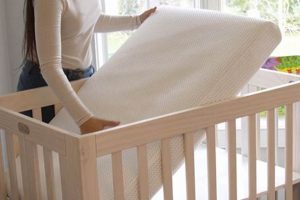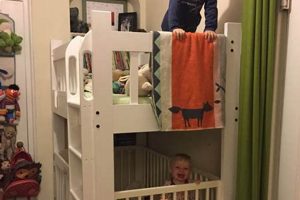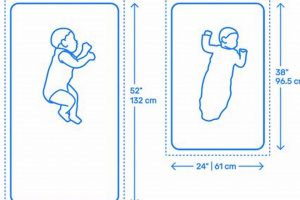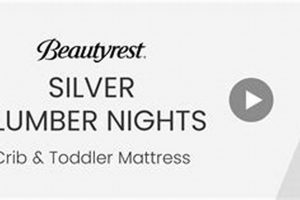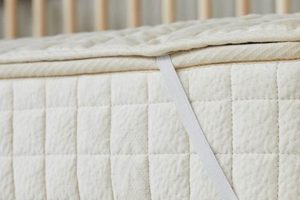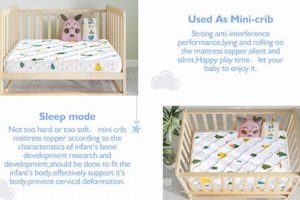Material placed on top of a crib mattress to enhance comfort or protection is often referred to as an overlay. These additions can range from thin, quilted layers designed to wick away moisture to thicker, more substantial materials intended to soften the sleeping surface. The use of such items aims to create a more pleasant rest environment for infants.
The incorporation of a supplementary layer on a child’s mattress can improve sleep quality by offering increased cushioning. Historically, parents have sought ways to optimize their children’s sleep surfaces. Modern iterations offer enhanced breathability, temperature regulation, and protection against allergens. While such additions are primarily intended to enhance comfort, it is crucial to ensure they meet safety standards and do not compromise the integrity or firmness of the original mattress.
Subsequent sections will explore specific types of overlays available, considerations for safety and material composition, and best practices for maintaining a clean and hygienic sleep environment for infants.
Guidance on Crib Mattress Overlays
The following guidance addresses important considerations when selecting and utilizing supplemental layers for infant sleep surfaces, focusing on safety and hygiene.
Tip 1: Prioritize Safety Certifications. Verify that any added layer meets recognized safety standards, such as those set by ASTM International, to minimize suffocation or entrapment hazards. Scrutinize labels and product descriptions for relevant certifications.
Tip 2: Ensure a Snug Fit. Any additional material should conform precisely to the dimensions of the crib mattress. Loose or ill-fitting layers can create dangerous gaps where a child could become lodged.
Tip 3: Opt for Breathable Materials. Select materials that promote airflow and reduce the risk of overheating. Natural fibers, such as cotton or wool, and specifically designed breathable synthetics are viable options.
Tip 4: Maintain Firmness. The addition of an extra layer should not significantly reduce the firmness of the underlying mattress. Infants require a firm sleep surface to minimize the risk of Sudden Infant Death Syndrome (SIDS).
Tip 5: Clean Regularly. Establish a routine cleaning schedule. Wash removable covers frequently according to manufacturer instructions. For non-removable components, spot clean with mild detergents and ensure thorough drying.
Tip 6: Monitor for Wear and Tear. Regularly inspect the overlay for signs of damage, such as tears, fraying, or deformation. Replace any compromised material immediately to prevent hazards.
Tip 7: Consult Pediatricians. If concerns arise regarding the suitability of an additional mattress layer, consult a pediatrician or qualified healthcare professional for personalized guidance.
Adhering to these guidelines will help create a safer and more hygienic sleep environment for infants.
The subsequent sections will delve into specific material choices and cleaning protocols in greater detail.
1. Firmness
Firmness is a crucial consideration when selecting padding for a crib mattress. The primary function of a crib mattress is to provide a firm, flat surface to reduce the risk of Sudden Infant Death Syndrome (SIDS). Introducing supplemental padding necessitates careful evaluation to ensure the existing firmness is not compromised.
- Impact on Infant Development
Excessive softness can hinder infant motor skill development. A yielding surface makes it more difficult for a baby to push up, roll over, or crawl, impeding muscle strength development. Supplemental materials must maintain adequate support for these developmental milestones.
- Risk of Suffocation
A soft or overly plush surface presents a suffocation hazard. An infant’s face can sink into the material, obstructing airways. Padding should be firm enough to prevent indentation and maintain consistent air circulation.
- Compliance with Safety Standards
Many safety organizations have set firmness standards for crib mattresses. It is essential that any supplemental layer does not bring the combined sleep surface outside the acceptable firmness range. Reviewing compliance with ASTM standards is critical.
- Material Density and Composition
Material choice directly affects firmness. High-density foams or tightly woven natural fibers offer superior support compared to loosely packed synthetics. The composition must provide resistance to compression and maintain a consistent level of firmness over time.
Therefore, when adding a layer atop the crib mattress, careful consideration of firmness is paramount. Compromising firmness for perceived comfort can introduce serious safety risks. The ideal addition should enhance, but not detract from, the original intended firmness of the crib mattress.
2. Breathability
Breathability, in the context of crib mattress overlays, refers to the capacity of a material to permit air circulation. This is paramount to regulating an infant’s body temperature and mitigating potential health risks associated with overheating and restricted airflow.
- Thermoregulation
Infants are less efficient at regulating their body temperature than adults. Overlays that impede airflow can contribute to overheating, increasing the risk of heat stress. Breathable materials facilitate the dissipation of heat, helping maintain a stable and safe body temperature for the infant.
- Reduction of Moisture Buildup
Materials with poor breathability can trap moisture from perspiration, drool, or spills. This creates a breeding ground for bacteria and mold, potentially leading to skin irritation and respiratory issues. Breathable materials promote evaporation, reducing moisture accumulation and maintaining a drier, more hygienic sleep surface.
- Minimizing Suffocation Risk
While firmness is the primary factor in reducing suffocation risk, breathability also plays a critical role. In the event an infant’s face presses against the overlay, a breathable material allows for some degree of continued airflow, mitigating the risk of airway obstruction.
- Material Composition and Construction
The choice of materials and their construction significantly affects breathability. Natural fibers, such as cotton and wool, are generally more breathable than synthetic materials like vinyl. Open-weave constructions also enhance airflow compared to tightly woven fabrics. Material selection directly impacts the safety and comfort characteristics of the sleep environment.
Therefore, the consideration of breathability is integral when evaluating supplementary materials for crib mattresses. Failure to prioritize this aspect can negate other safety benefits and compromise the well-being of the infant. Choosing materials that inherently promote airflow and moisture management is essential for creating a safer sleeping environment.
3. Hypoallergenic
The term “hypoallergenic,” when applied to padding intended for crib mattresses, signifies a reduced potential to cause allergic reactions. This designation is of particular importance given the heightened sensitivity of infants to environmental irritants and allergens.
- Material Composition and Allergenicity
Certain materials are inherently less likely to provoke allergic responses. Natural latex, for example, while sometimes marketed as hypoallergenic, can still trigger latex allergies in sensitive individuals. Synthetic materials such as polyester or polyurethane foam are often preferred due to their lower allergenic potential. Certification from organizations such as OEKO-TEX indicates testing for harmful substances, providing additional assurance.
- Dust Mite Resistance
Dust mites are a common allergen found in bedding. Hypoallergenic crib mattress overlays are often constructed with tightly woven fabrics or treated with dust mite inhibitors to minimize colonization. Effective dust mite barriers reduce exposure to these allergens, contributing to improved respiratory health for infants.
- Mold and Mildew Prevention
Moisture accumulation within mattress padding can foster mold and mildew growth, both of which are potent allergens. Hypoallergenic options often incorporate moisture-wicking materials or antimicrobial treatments to inhibit the proliferation of these organisms. Maintaining a dry environment within the mattress padding is crucial for preventing allergic reactions.
- Chemical Sensitivities
Infants are more susceptible to the effects of chemical exposure. Some conventional mattress padding materials undergo chemical processing, potentially leaving residual volatile organic compounds (VOCs). Hypoallergenic options prioritize materials with low VOC emissions, reducing the risk of chemical sensitivities and respiratory irritation. Certifications like GREENGUARD Gold indicate compliance with stringent chemical emission standards.
Selecting a hypoallergenic layer for a crib mattress demands careful consideration of material composition, construction techniques, and relevant certifications. Prioritizing these factors minimizes the risk of allergic reactions and promotes a healthier sleep environment for infants.
4. Water Resistance
Water resistance is a significant attribute for any material used as padding on a crib mattress. Infant care inherently involves the potential for spills, regurgitation, and diaper leaks. A lack of water resistance in the padding allows these liquids to penetrate the mattress core. This saturation creates an environment conducive to bacterial and fungal growth, leading to unpleasant odors and potential health hazards for the infant. Furthermore, repeated exposure to moisture can degrade the mattress material, shortening its lifespan and compromising its structural integrity. Therefore, water resistance serves as a fundamental protective barrier, maintaining hygiene and extending the usability of the crib mattress.
The practical application of water resistance manifests in various material technologies. Many crib mattress pads utilize waterproof membranes, often composed of polyurethane or polyethylene, laminated to absorbent layers. These membranes prevent liquid penetration while allowing for breathability, mitigating the risk of moisture buildup. Alternatively, tightly woven fabrics treated with hydrophobic coatings offer a degree of water resistance without sacrificing air circulation. In instances where complete water impermeability is not achievable, the pad should, at a minimum, facilitate quick drying to minimize the duration of moisture exposure to the underlying mattress.
Ultimately, water resistance is not merely an added benefit but a necessary characteristic of padding intended for crib mattresses. It safeguards against unsanitary conditions, reduces the risk of microbial contamination, and contributes to the longevity of the mattress. Selecting pads with verifiable water-resistant properties ensures a cleaner, healthier, and more durable sleep environment for infants. The challenge lies in balancing water resistance with breathability to optimize both protection and comfort.
5. Secure Fit
The concept of “secure fit” is paramount when considering additional padding for crib mattresses. An appropriately fitted overlay is essential for preventing hazardous conditions and ensuring optimal safety for the infant.
- Minimizing Entrapment Risk
An ill-fitting overlay, whether too large or too small, poses a significant entrapment risk. Overly large padding can bunch up or fold, creating gaps between the mattress and the crib sides. An infant could become wedged in these spaces, leading to suffocation or injury. A properly sized and secured overlay eliminates these potential hazards.
- Maintaining Mattress Firmness
A secure fit helps maintain the designed firmness of the crib mattress. If the overlay is not properly secured, it can shift and create uneven surfaces. This unevenness can reduce the effectiveness of the firm mattress surface, potentially increasing the risk of Sudden Infant Death Syndrome (SIDS). A snug fit ensures consistent and uniform support across the entire sleep surface.
- Preventing Displacement During Movement
Infants move frequently during sleep. An unsecured overlay can easily become displaced, bunching up under the infant or creating a loose surface. This displacement not only disrupts sleep but also increases the risk of entanglement or suffocation. A secure fit ensures that the padding remains firmly in place, regardless of the infant’s movements.
- Facilitating Proper Crib Sheet Functionality
A well-fitting overlay allows for the proper use and functionality of crib sheets. If the padding is too bulky or does not conform to the mattress dimensions, it can interfere with the sheet’s ability to fit snugly and securely. This compromised sheet fit can create loose fabric, posing a suffocation hazard. Securely fitting padding enables the crib sheet to function as intended, maintaining a safe and streamlined sleep environment.
The facets of secure fit directly influence the safety and effectiveness of padding on a crib mattress. Prioritizing proper dimensions and secure attachment mechanisms is crucial for minimizing risks and creating a safe sleeping environment. The selection process should emphasize products that are specifically designed to fit the crib mattress dimensions precisely and offer features that prevent shifting or displacement during use.
6. Washability
Washability is a paramount consideration when evaluating supplemental materials for crib mattresses. Infants inevitably generate spills, regurgitation, and diaper leaks, events which can quickly soil the sleep surface. The porous nature of most padding materials allows these contaminants to penetrate, creating a breeding ground for bacteria, mold, and mildew. Without regular and effective cleaning, these microorganisms can proliferate, leading to unpleasant odors and potentially causing skin irritation, respiratory issues, or allergic reactions in the infant. Washability, therefore, becomes not merely a convenience but a crucial element in maintaining a hygienic and safe sleep environment.
Effective washability extends beyond simple surface cleaning. Padding designed for crib mattresses should ideally be machine washable and dryer-safe to ensure thorough sanitization. Removable covers facilitate this process, allowing for easy removal and laundering without compromising the integrity of the underlying padding material. In cases where the padding is not removable, the material should be capable of withstanding frequent spot cleaning with mild detergents without degradation or discoloration. For example, a crib mattress overlay constructed with tightly woven cotton and featuring a waterproof backing can be effectively cleaned in a washing machine, removing allergens and contaminants, while the waterproof layer protects the underlying mattress from saturation. Regularly washing the padding reduces the microbial load and maintains a cleaner sleeping surface for the infant.
In summary, washability is inextricably linked to the health and safety performance of crib mattress padding. The ability to effectively clean and sanitize these materials is essential for preventing the proliferation of harmful microorganisms and maintaining a hygienic sleep environment. Selecting padding with verifiable washability characteristics, such as machine washability and dryer-safe construction, is a critical step in safeguarding infant well-being. The ongoing challenge lies in balancing washability with other essential features like firmness, breathability, and allergen resistance to achieve a comprehensive and effective sleep solution.
Frequently Asked Questions
The following addresses common inquiries regarding the selection and use of supplementary materials for infant crib mattresses.
Question 1: What constitutes acceptable material for a crib mattress overlay?
Acceptable materials typically include tightly woven cotton, breathable synthetics like polyester, or natural fibers such as wool. The primary criterion is the material’s ability to maintain a firm, flat surface and facilitate adequate airflow.
Question 2: How frequently should a crib mattress overlay be cleaned?
The overlay should be cleaned immediately following any soiling incident. Routine cleaning, ideally weekly, is also recommended to minimize the accumulation of allergens and bacteria.
Question 3: Does the addition of padding void the crib mattress warranty?
The impact on warranty varies by manufacturer. Consult the crib mattress warranty documentation to determine if the use of supplementary padding voids the warranty agreement.
Question 4: Is there a maximum thickness recommended for crib mattress overlays?
There is no universally mandated maximum thickness. However, the overlay should not significantly reduce the firmness of the underlying mattress. A general guideline suggests limiting thickness to no more than 1 inch to maintain adequate support.
Question 5: Can a standard mattress pad be used on a crib mattress?
Standard mattress pads designed for adult beds are generally not suitable for cribs. They may not fit securely, potentially creating hazardous gaps. Utilize only pads specifically designed and sized for crib mattresses.
Question 6: How can one verify the safety of a crib mattress overlay?
Seek products that have been certified by independent organizations such as ASTM International or GREENGUARD. These certifications indicate that the product has undergone testing and meets established safety standards.
Prioritizing safety, hygiene, and appropriate fit are crucial when selecting and utilizing supplemental layers for infant sleep surfaces.
The subsequent sections will explore specific product recommendations and purchasing considerations.
Conclusion
The preceding discussion has explored the multifaceted considerations surrounding padding for crib mattress. The analysis emphasized crucial aspects, including material composition, safety certifications, firmness, breathability, water resistance, secure fit, and washability. Each factor contributes to the creation of a sleep environment that minimizes potential hazards and promotes infant well-being. The selection and implementation of such padding must adhere to stringent safety guidelines to mitigate risks associated with suffocation, overheating, and allergic reactions.
Given the critical role of a safe and hygienic sleep environment in infant development, the informed selection of appropriate padding for crib mattress remains paramount. Continued adherence to established safety standards and ongoing vigilance in monitoring the product’s condition are essential for ensuring infant safety and well-being throughout its use. The informed application of the guidelines discussed here provides a foundation for making responsible choices regarding supplemental padding for crib mattresses.


